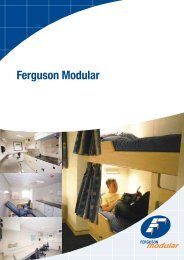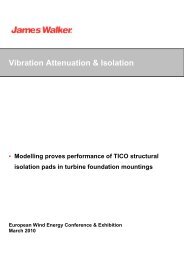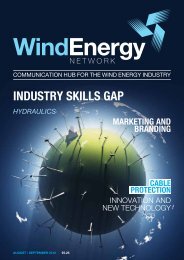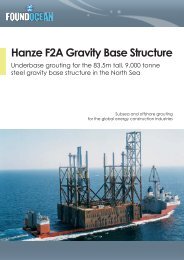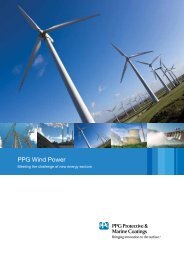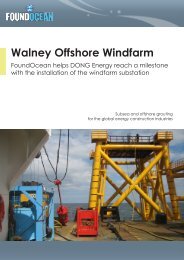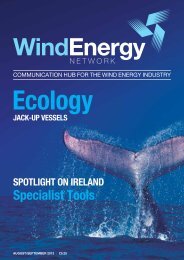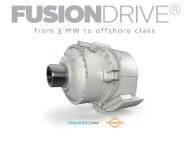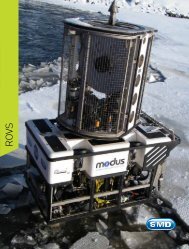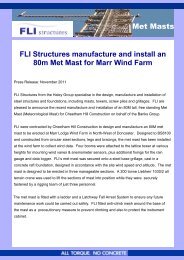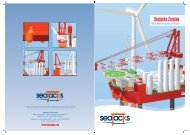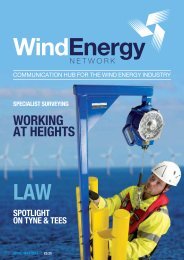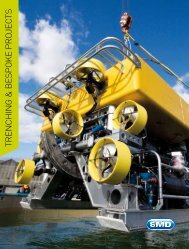JUNE/JULY 2013 | £5.25 - Wind Energy Network
JUNE/JULY 2013 | £5.25 - Wind Energy Network
JUNE/JULY 2013 | £5.25 - Wind Energy Network
Create successful ePaper yourself
Turn your PDF publications into a flip-book with our unique Google optimized e-Paper software.
developments in foundation technologydevelopments in foundation technologyThe role of InnovationThere is an ever-increasing view thatInnovation will lead to large savings inthe cost of foundations for deeper waterprojects. A great deal of funding is beingprovided by the likes of DECC and theCarbon Trust to develop innovativefoundation solutions to drive costs down.The danger is that the search for theultimate will defer decisions or worst stillwill result in adopting solutions that are notsuitable for the harsh conditions found farout in the North Sea.Cost analysisSome developers view the cost of thefoundation in isolation, believing thatmaking a marginal saving on steel weightwill make a significant impact in the overallinstalled cost. This approach exposesthe developer to unpredictable offshoreinstallation risks and cost escalations.A better approach is to view the installedcosts of the foundation separately tothe tower and nacelle as they have theirown unique criteria laid down by theturbine manufacturers. You can knock asteel jacket about during installation butcertainly not a turbine. The foundation andthe turbine require different installationvessels type and such an approach willreduce installed costs.By developing foundation solutions thatextend the offshore installation weatherwindows will also reduce the costsand also the overall number of vesselsrequired.Novel solutions = potential increased risks.Currently there are a number of deeperwater wind farms in Europe that are beingdeveloped using steel jacket foundationsrather than monopiles. In parallel there aremany novel solutions being proposed fordeeper waters but this represents anotherarea of potential risk.Floating structuresFloating type structures appear to be astraight forward and obvious solutionbut they carry a significant operationalrisk. Offshore oil & gas has around 20floating production platforms (FPSOs)deployed in the North Sea, all havemooring integrity issues and some havesuffered major mooring failures. DrillingRigs too have suffered similar issues andfailures. Over the past 10 years the HSEhas implemented a rigorous, expensiveinspection regime the cost of which hashad to be absorbed by the oil companies.The question is can the marginal windfarms OPEX sustain such costs with largenumbers of moorings being proposed?It is well known in the oil & gas industrythat mooring systems in waters of lessthan 100 metres experience tensionwaves in the mooring lines increasing therate of wear and tear.CorrosionCorrosion is also a concern. For example,let’s assume a site located in 60m waterdepth with say 200 turbines supported ona floating structure secured by six mooringlines and anchors. This amounts to1200 mooring lines each a potentialfailure point; this is far in excess ofthe number of FPSO mooring linescurrent deployed in the North Seaand represents a significant threatto the operational viability of thehypothetical wind farm.The turbine manufacturersplace very strict verticalitycriteria for the installedtowers and this is atodds with the floatingconcepts which will move around withthe sea conditions amplifying horizontalaccelerations high up at the nacelle.Novel ideas and innovation have theirplace and role to fulfil but they need tobe firmly placed under the microscopeand fully risk assessed using the valuableexperience of the oil & gas industry.The role of IndustrialisationThe majority of foundations for offshorewind turbines have, up until now, been of amonopile design. These are comparativelysimple structures with the only realdesign variable being the diameter andwall thicknesses of the pile. Hence whenconsidering theconstruction of suchitems it is fairly easyto apply known andwell proven automationtechniques to thehandling and welding ofthese structures. Themove of offshore windfarms into deeperwater will ultimatelynecessitate a moveaway from monopilefoundations to morecomplex structuressuch as latticeframework jackets,which have nowA moored floatingwind turbinesupport structureDeeper waters and novel solutionsbeen used in a small number of locationsaround the UK and European waters.These jacket foundations have been usedby the offshore oil and gas industry formany years and involve the fabricationof many welded node joints betweenthe tubular elements that make up thelattice. To date, both in the oil and gasindustry and in the offshore wind industry,these complex joints have been primarilyconstructed by manual welding methodsand are therefore a long and costlyprocess. If such structures are to be usedin large numbers in the offshore windindustry then such manual fabricationmethods cannot prevail, neither in termof cost nor that of capacity. There simplyaren’t enough large fabrication facilities inEurope to meet the demand for jacketsusing traditional fabrication methods. Noris the wind industry able to pay for suchexpensive production methods.Mass productionWhat is needed in the industry is a moveaway from the ‘artisan’ approach of‘bespoke designed’ and ‘hand crafted’jacket to a much more ‘industrialised’ and‘mass production’ attitude.This ‘industrialisation’ must start withthe design of the jacket. They have tobe designed with ‘low cost’ productionin mind. It isnot enough toproduce elegantdesigns that arevery efficient in useof steel, nor onesthat are cheapto install. Theyalso need to beeasy and cheapto manufacturein large numbers.The winningjackets will bethose that canhit the ‘sweet spot’ between design,manufacture and installation.The Target must be to hit the ‘SweetSpot’In order for jackets to be massmanufactured they must be ‘predominantly’the same. This is despite the water depthand geotechnical conditions for eachwind turbine being unique. It is thereforenecessary to consider a jacket designwhere, say 80% of the jacket is identical fora given wind turbine. In this case many ofthe component members of the jacket canbe the same and production cells can beset up to cheaply and rapidly manufacturethese common parts. Similarly if thegeometry of the jackets is common, then‘standard’ fit up jigs and tooling can be usedto ensure that the lengthy process of jacketassembly can be substantially reduced. Inthe ‘standard methods’ of fabrication it iscommon for set up to take 80% of the totalfabrication time. This cannot be tolerated ina fully ‘industrialised’ process.Furthermore if we are to introduce roboticor automated welding and handlingtechniques then we have another driver forstandardised designs so the welding andhandling equipment does not have be setup differently for each jacket produced.Standard designs will also haveadditional advantages when it comesto transportation and installation. Seatransport grillages can be kept the same.Handling rigs can be identical. All theseperipheral items can add substantial coststo an offshore wind project.SummaryThe basics of mass production have beenused in other industries for years. We justneed to learn the lesson and adapt them sothat we can apply them to reduce the costof jackets for the offshore wind industry.To reduce the Levelised Cost of <strong>Energy</strong> toacceptable levels we need to attack thecost of wind projects at all levels.There is unlikely to be a single ‘silver bullet’that is going to save the day – much morelikely that we will achieve our target by ‘athousand cuts.’Graham KennedyOGN Aquindwww.ogn-group.comClick to view more info36 www.windenergynetwork.co.ukwww.windenergynetwork.co.uk 37



